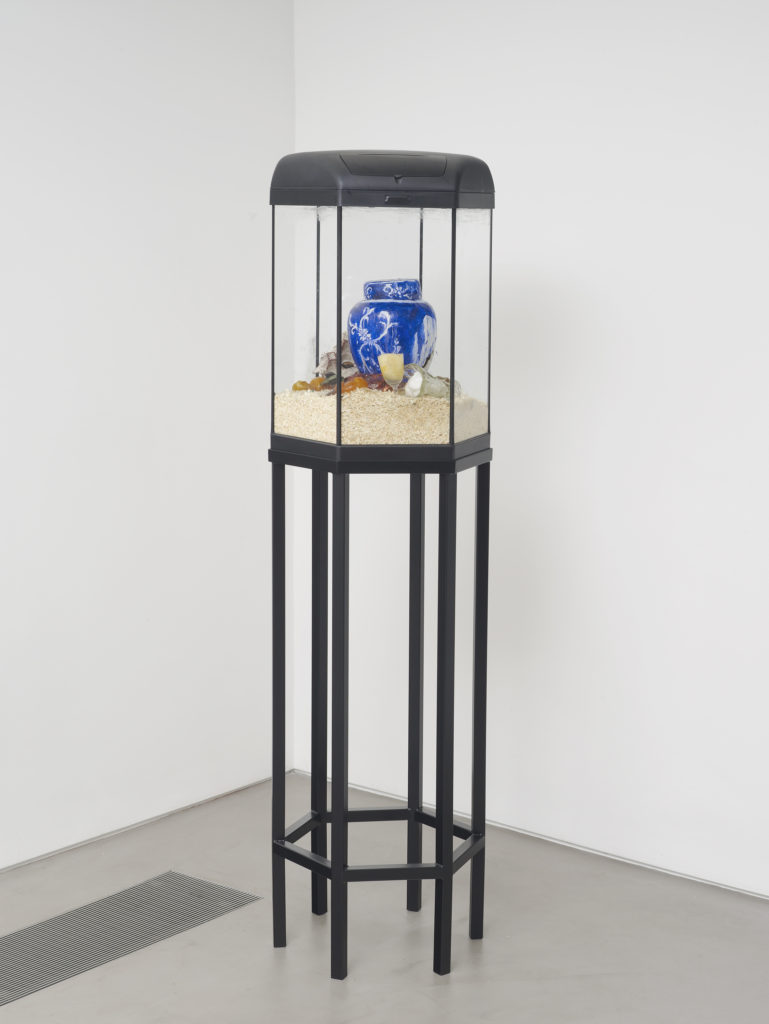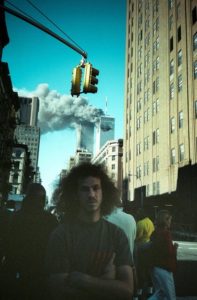“We’ll see how it goes,” says Candice Lin, looking at a glass case full of giant cockroaches in the corner of London’s Gasworks. “They made babies which we were all a little nervous about because there are some gaps. They’re a little worried that they’re going to have an infestation.” The work is a part of the LA-based artist’s first UK solo exhibition that’s called A Body Reduced to Brilliant Colour – running September 21 to December 11 – and boasts porcelain, sugar, tea, live silkworms (“cute”), opium, silver and a red dye made from the bodies of insects called cochineal. All of these things are perishable and all of them threaten the clinical ambience of a recently renovated gallery.

The show hasn’t even opened yet and there’s already been an issue with the water filtration system. The makeshift rigging of tubes, glass jars and ceramics, poppy seeds and a couple of potatoes, has been fermenting, distilling and dying its contents into a rich liquid composite that risks spilling out of its wooden container. “Their floor is new and it stains easily,” Lin explains, “but so far it’s not got any red on it.”
Spread between rooms, A Body Reduced to Brilliant Colour includes a Chinese reproduction of a Dutch still life with a Chinese porcelain jar, an etching of a slave-driven silver mine, and an upturned ceramic bust of Scottish Botanist and tea-thief Robert Fortune being used as a filter. There’s a pile of books titled Opium for the Masses, Science and Colonial Expansion and The Global Lives of Things holding up one of the copper stills of the aforementioned installation called ‘System for a Stain’. A hose spurts crimson on to a fake marble floor next door. “It actually doesn’t look very brown,” says Lin about the piece that circulates like an artery of bacterial fermentation between the two spaces. “We thought it would look more like menstrual blood. It’s more like a really pretty red.”
When I return to the exhibition two months later, though, the water has turned a rank, congealed brown. The candied vase in the vitrine of cockroaches has melted from the English humidity (“I didn’t think about the weather”), and the room is pungent. The overpowering smell of decay has become a part of the show, becoming assimilated in a violent, though complex life cycle of trade and goods-exchange that affects every living organism, down to the bacteria that runs through them. Suddenly the audio, coming from a speaker over the maroon blot has more meaning:
“My father said you could never trust an Indian no matter how well you thought you knew him, they were mercurial and prone to leave before the contract was up, and so sometimes you had to keep their children.”
When I first heard ‘A Memory Blushing with Innocence,’ Lin’s words, read by Lauren Mackler, were muffled by the noise and excitement of an opening night crowd. Now the room is empty, quiet and stale. The crisp white gloves for leafing through George Psalmanazar’s Physiologus text are now a grimy light-grey. The pages of the made-up language of Formosa written by the self-styled 18th century ‘Oriental chimera’ have been turned enough, and the show is finally ripe. Its references run thick and complex, constantly evolving and seeping through a practice that’s as compelling as it is deeply implicating.

When you talk about the colonial constructs in the language of objects, is the root here in British Imperialism?
Candice Lin: Yeah, my research on these topics started in the Caribbean because I was actually looking at religious objects, or dances, or things that had these elements that migrated, these syncretic objects or dances in Vodou religion that came out of that. From that research in the Caribbean I started thinking about food goods and then from there, I was thinking a lot about the relationship between America, the Caribbean and the UK, or England, at the time. So in this show there is a focus on the way that the objects were important to British culture, like tea, sugar and potatoes.
What do you mean by syncretic objects?
CL: Syncretic objects would be the way that in certain ritualistic dances in Vodou, for example, they have traces of French court dances, freemasonry stepping rituals and military movements. It’s the way that these different histories all get kind of boiled down into a form, or the way certain objects would have these multiple histories in them.
So you mean in terms of a kind of cultural exchange.
CL: Yeah, in the way things are hidden as a way to survive. So with Vodou it’s a way to hide your native religion in the guise of the master’s religion. But I was also interested in ways that things morph over time, creating new meanings and new relationships.
When you say hiding a religion ‘in the guise of the master’s religion,’ which one are you talking about?
CL: Haitian Vodou draws from West African Vodun practiced by the Fon and Ewe people, as well as other religious elements of the Yoruba and Kongo. Those gods were syncretically linked to different Catholic Saints, so they would look like they were worshipping the Virgin Mary but actually they were also worshipping their own god because they weren’t allowed otherwise. That was interesting to me but I was also interested in the way that that got embedded in these daily objects more, and just even in these daily gestures.

It’s also interesting how that works the other way around, in terms of imposing a religion, or an ideology by using the images of another belief system, in the same way that Christianity would have done with Paganism for example.
CL: Yeah, I think that’s true. Paganism and the way the tree symbolism becomes the cross, and then the cross becomes the Aztec crossroads, or the Incan crossroads in the New World. Both have layers of these different meanings kind of packed on top of each other.
I wonder what you think about colonialism, then, as a concept. Your approach seems far more multifaceted.
CL: Yeah, it’s almost as if colonialism is an easy way to talk about it but it is much larger than that. I always say that I’m more looking at, or starting from the imperial or colonial root of the traded object and then it’s something else completely, as it spreads outwards and becomes this layered, complex object with all these different sets of relations going on.
Do you think it’s particularly relevant at this point in time that you’re working with food?
CL: I’m actually kind of moving from food to thinking about plants and bacteria but I think food is so interesting because it’s this shared experience that’s almost a ritual. It’s like a domestic ritual that’s a little bit indoctrinating – food types as a way of learning about culture. Then it’s also this thing that is changing all the time and embroiled in these different cross-cultural moments.

Also, because a lot of my work was much more about sexuality before, there is this idea of the porousness of the body that gets opened up when you talk about food. You’re like, ‘oh yeah, we aren’t these self-contained cases that are individuals, that are protected. We have all of these fissures, this kind of openness.’ So making people eat food that’s outside of the taboos, or making people think about these cultural things while they’re eating, that part is important to me.
You think eating is taboo?
CL: No. I did a meal in 2014 at the Delfina Foundation, where I had dishes that were based on English medieval traditions of making foods that look like one thing but they’re made out of another. One of them was insects and there’s a taboo around the English not eating insects. Then there’s this act of having to change your actual body by ingesting this thing that you find repulsive, physically, and breaking that emotional cultural taboo while you’re doing it.
Also with A Body Reduced to Brilliant Colour, transforming these goods into excrement…
CL: …or the excess residue that doesn’t have any purpose.
I first came across your work with the public sculpture for Current LA. Can you tell me something about it?
CL: That work is actually related to some other research for the show here that dealt with water filtration and the use of the history of porcelain, which is one part of the goods that I’m looking at in this show. Porcelain, sugar, tea, opium, silver and cochineal – quite a lot of things [laughs]. I was looking at ways that these historical colonial goods that were traded had language used to describe them that was sometimes racialised, or made in these human surrogates.
That piece in LA was called ‘A Hard White Body’ because of the way porcelain was described, often as this kind of parallel that showed these fears around miscegenation. They would talk about how porcelain could not be stained by tea or coffee, so there’s this kind of fear of foreign products. I’m interested in that with some of these other objects, as well. Tobacco was something I didn’t include but it was also talked about as ‘going mulatto’ when it got a virus. So there was explicit racialised language that was used for these different traded goods but also more subtle ones.

That sort of classification reminds me of the hierarchies embedded in the use of ceramic materials.
CO: Yeah, there’s Bone China, which was the English attempt at making porcelain and used actual bones of animals because of a mistranslation of Chinese. It said kaolin is to the bone as petuntse is to the flesh, and then they translated it literally. [laughs] Like, ‘oh, there’s bones and flesh in this special recipe!’
Can I ask at what point you started becoming interested in the history of…
CL: …things? [laughs]
Yeah.
CL: Always. I don’t know. I think I use my art as a way to synthesise and research things I’m interested in. So if I’m interested in bugs or parasites then I’ll research that and make a show about it. [laughs]
Do you read a lot?
CL: Yeah. I always never know how much I should say because I could go on but I don’t think that everybody needs to know everything.**
Candice Lin is an Los Angeles-based artist. Her A Body Reduced to Brilliant Colour is on at London’s Gasworks, running September 21 to December 11, 2016, and The Mountain is on at LA’s Commonwealth & Council, running November 19 to January 7, 2017.
















